
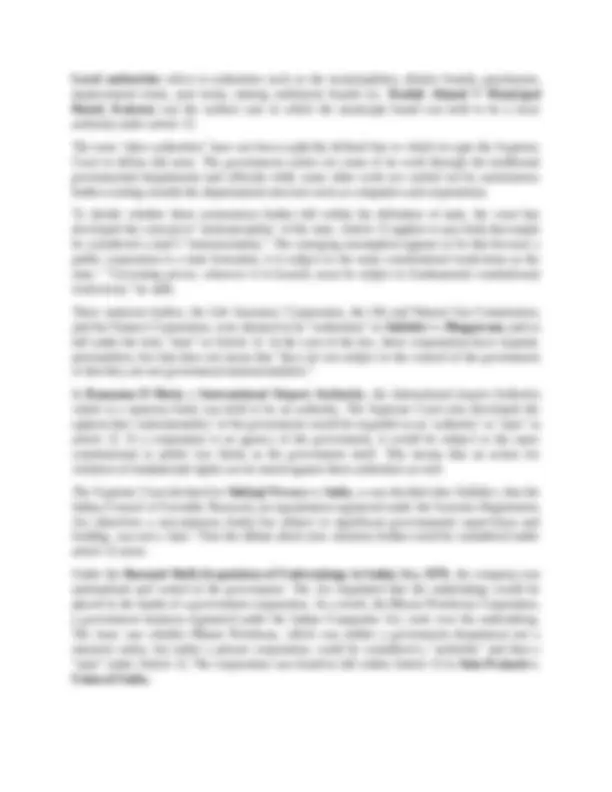

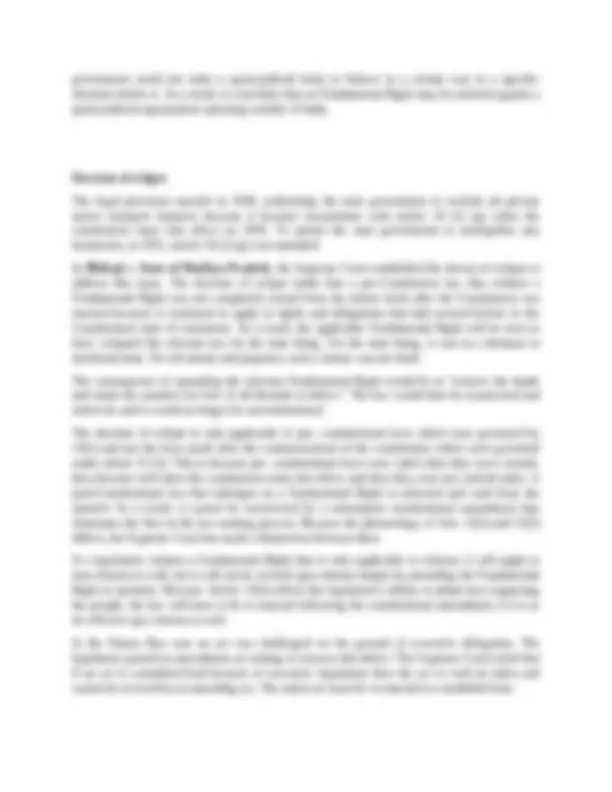
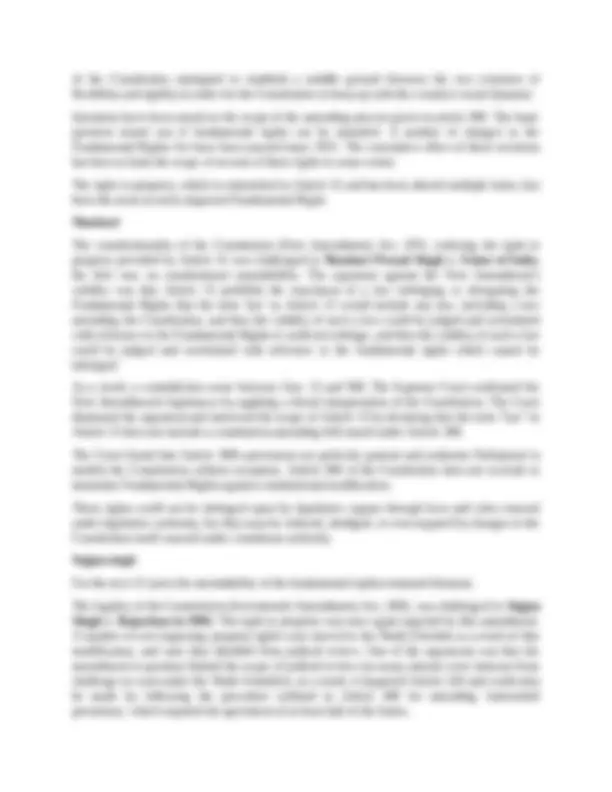
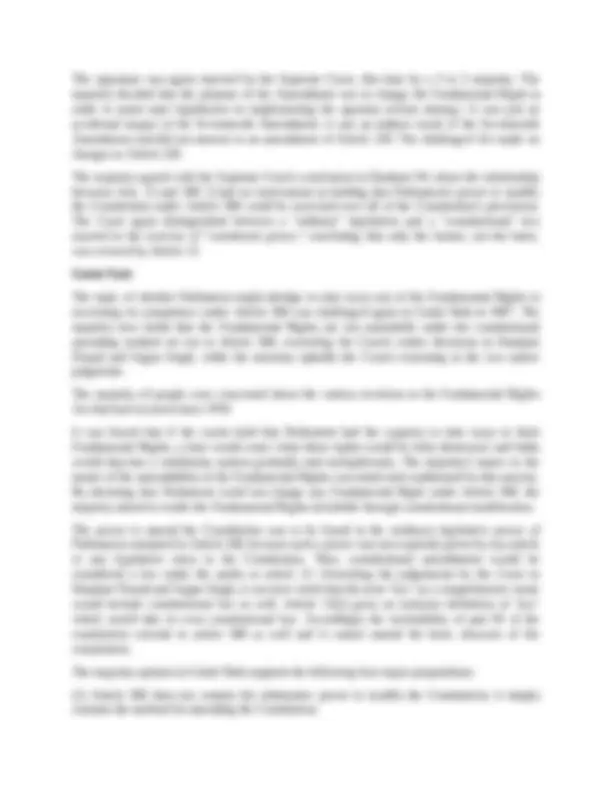





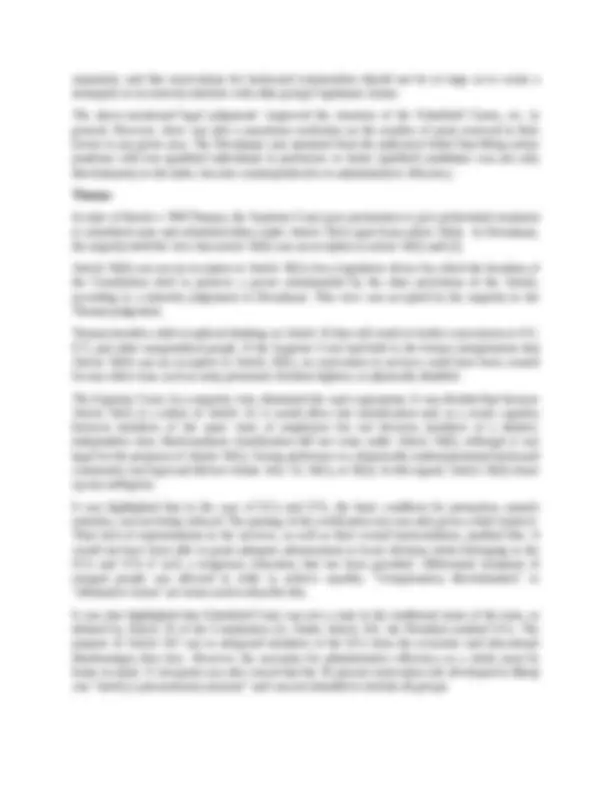
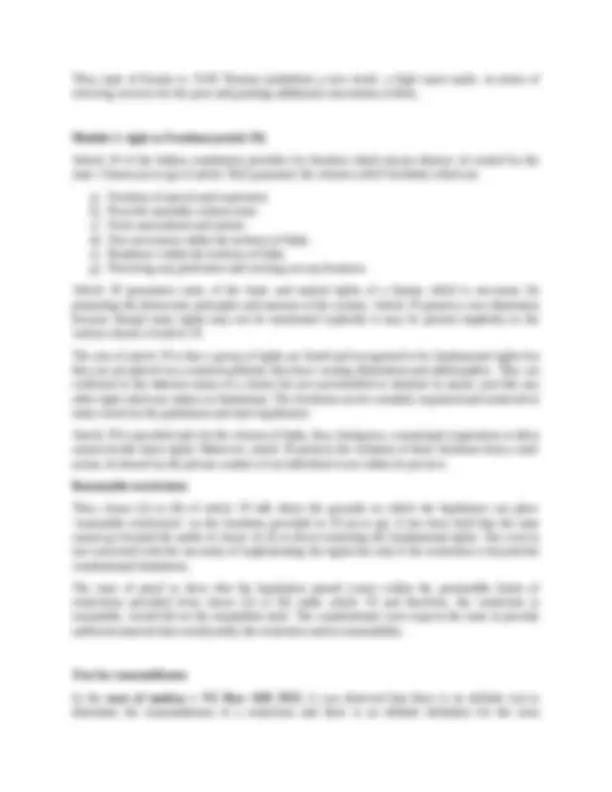
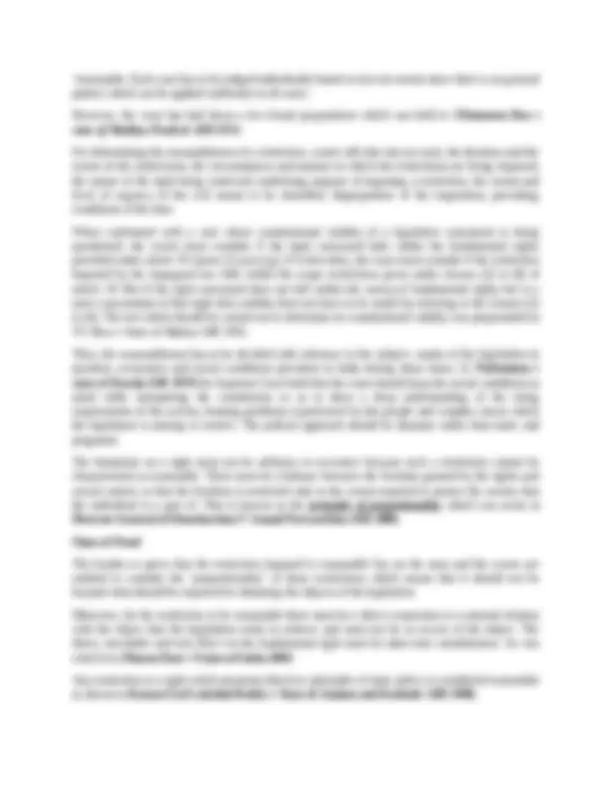





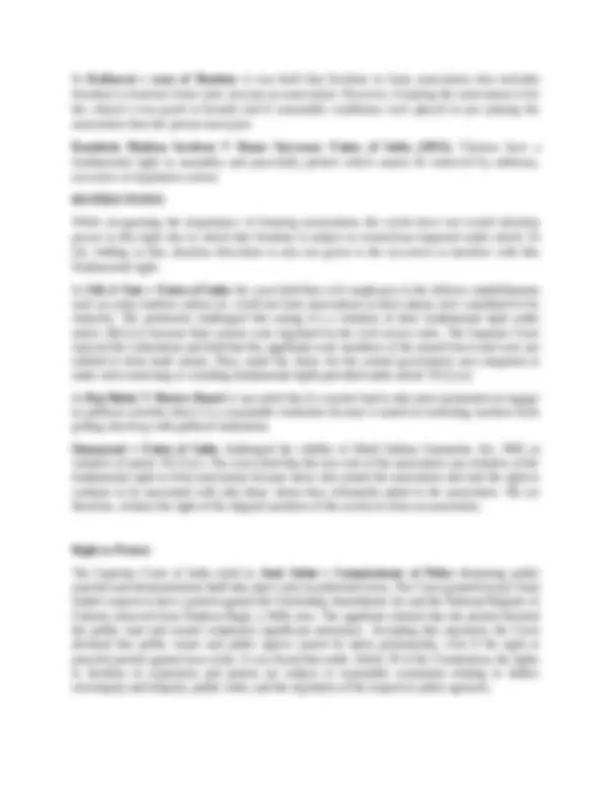



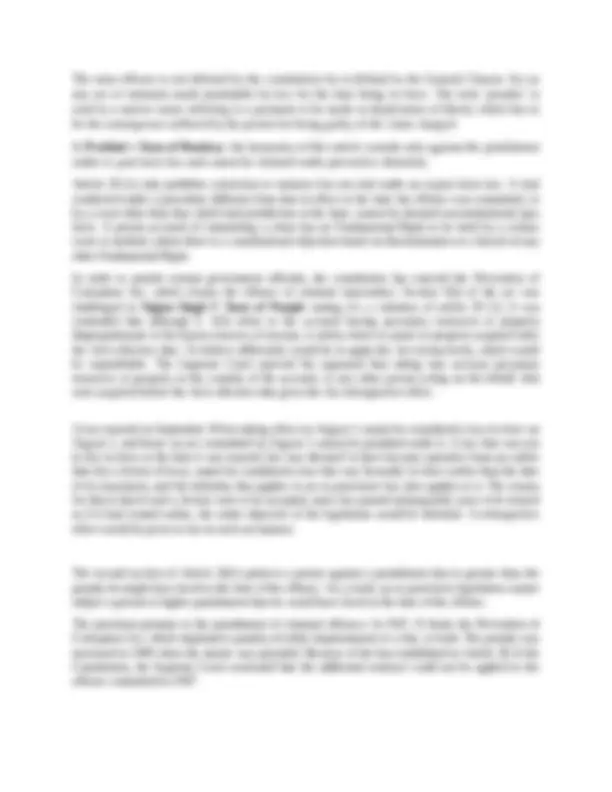
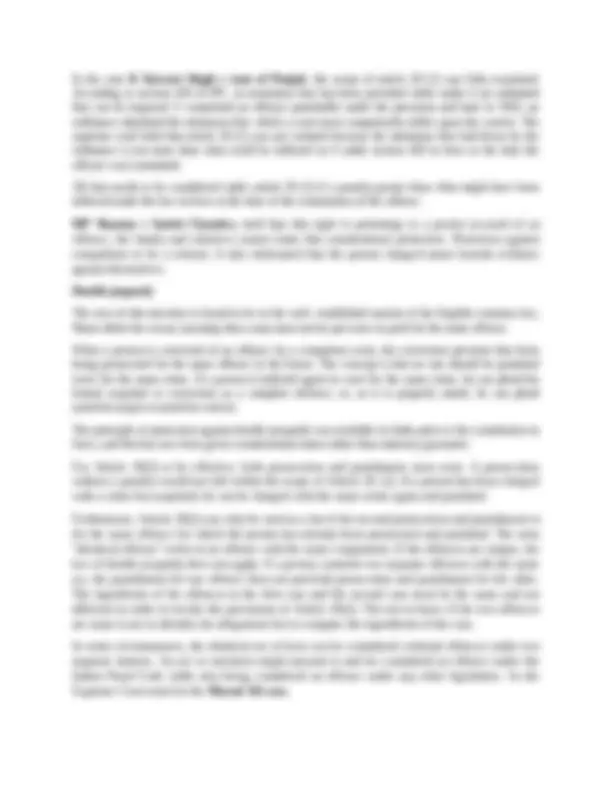
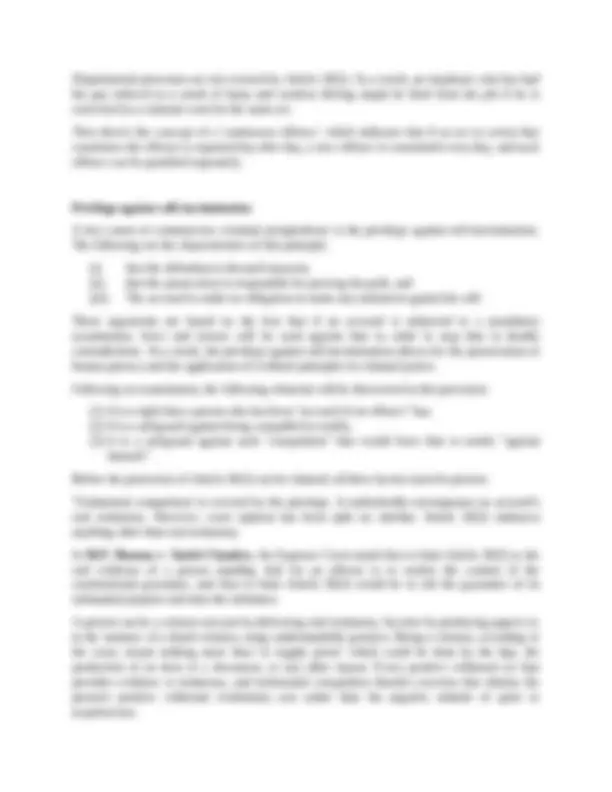
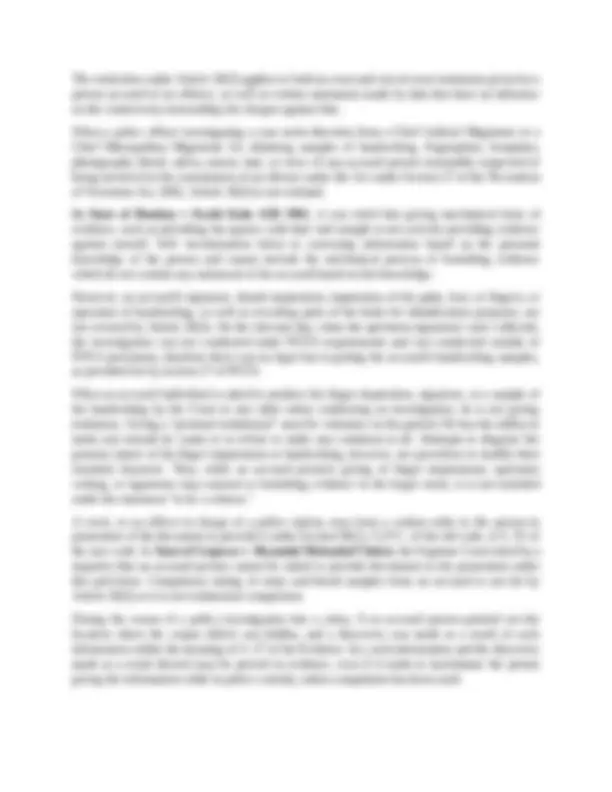

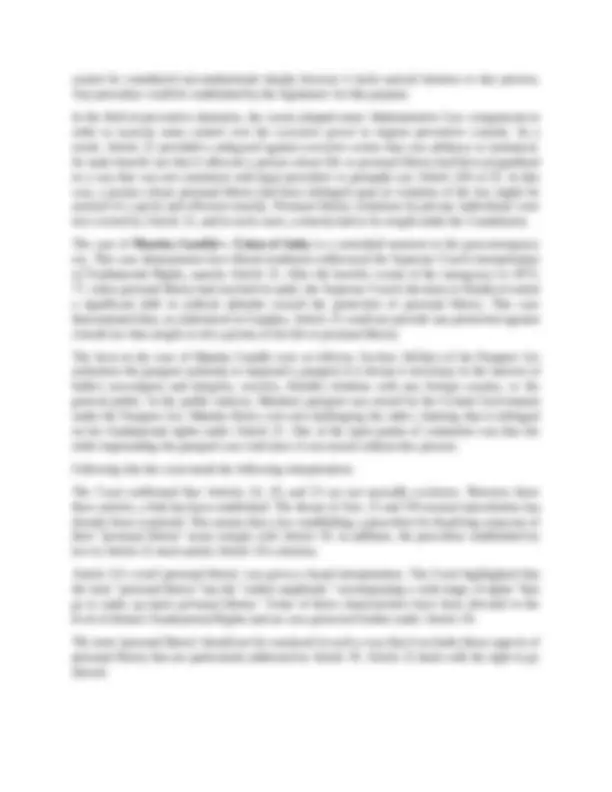

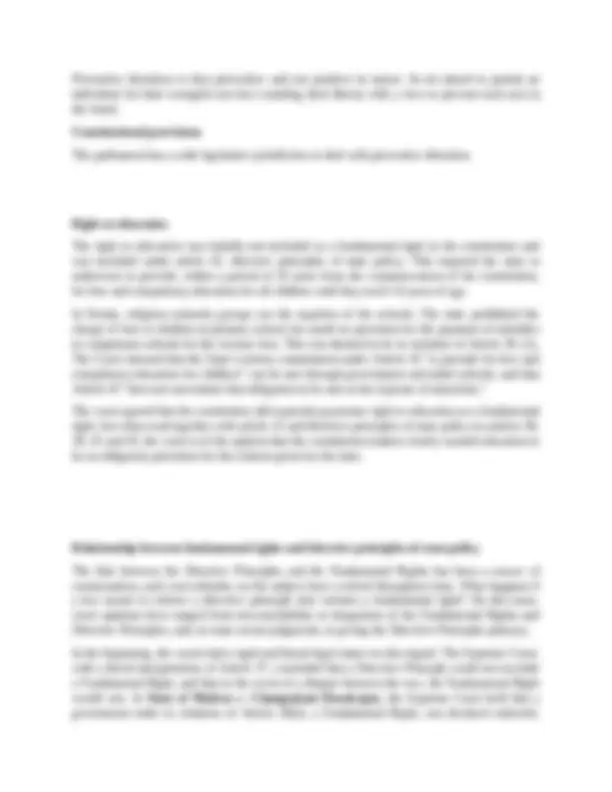
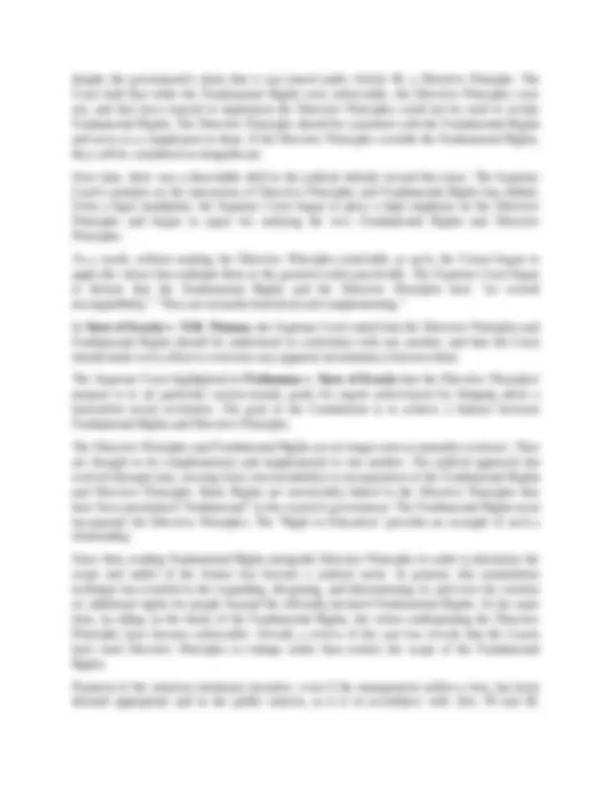



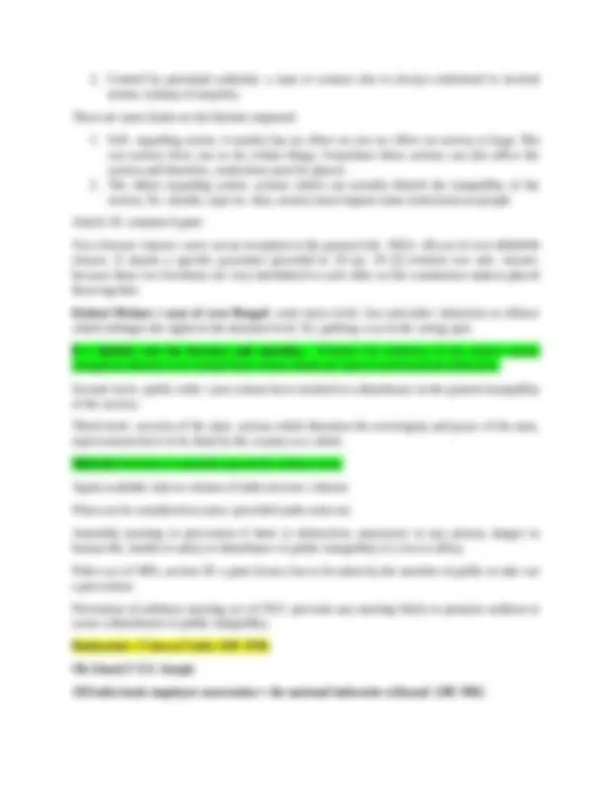




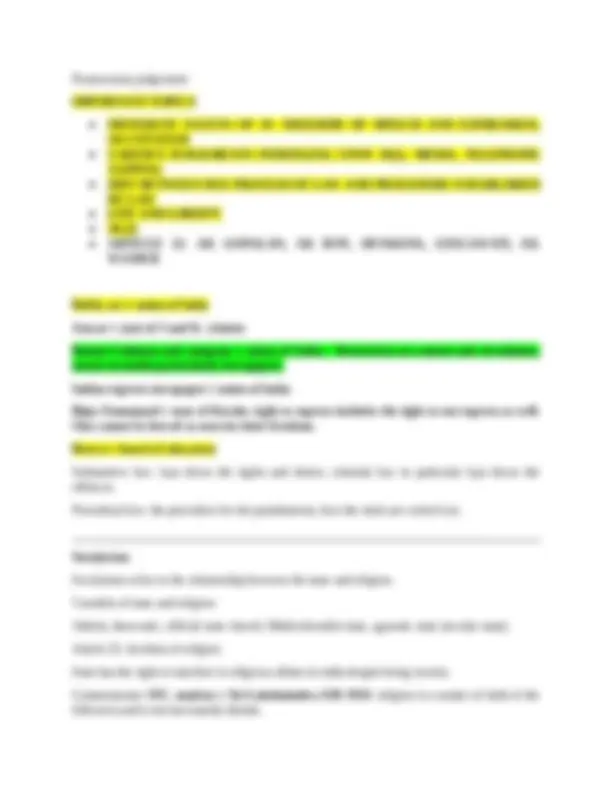



Study with the several resources on Docsity

Earn points by helping other students or get them with a premium plan


Prepare for your exams
Study with the several resources on Docsity

Earn points to download
Earn points by helping other students or get them with a premium plan
Community
Ask the community for help and clear up your study doubts
Discover the best universities in your country according to Docsity users
Free resources
Download our free guides on studying techniques, anxiety management strategies, and thesis advice from Docsity tutors
The concept of fundamental rights in the Indian Constitution. It explains how fundamental rights are claimed against the state and how they place a limitation on the government. The document also covers the seven categories of fundamental rights and the role of the Supreme Court in interpreting and protecting these rights. Additionally, it discusses the doctrine of eclipse and how it applies to pre-constitutional laws that violate fundamental rights. The document concludes by discussing the Shama Rao case and how it supports the proposition that an article held invalid under article 13 (2) could not be revived merely by amending it but will have to be re-enacted as a whole.
Typology: Study notes
1 / 49

This page cannot be seen from the preview
Don't miss anything!










































Constitution Module 3- fundamental rights Fundamental rights was developed from the west like several other ideas and concepts. The fundamental rights are claimed against the state, unlike the other rights which are created by the state and given to the individuals against one another. Hence, even if the constitution states them or not, it is generally assumed that the fundamental rights can be available only against the state or the government officials. Although there are some rights in the constitution which are expressly applicable to non-state action and some others are not expressly confined to state action. Article 12- 35 of the constitution provides the fundamental rights which are similar to the bill of rights available in the US constitution. But the former cover a much wider ground than the latter. Fundamental rights have dual aspects; one is that they confer certain rights which are justiciable to the citizens and can be used against the government and the other is that it imposes restrictions on the functions of the government. In the case PD Shamdasani V Central Bank Of India ltd., the petitioner sought the protection of the court in enforcing the rights given under article 19(1) (f) and 31 against the central bank of India. The court rejected it saying the structure of article 19 was such that it was intended to protect those freedoms against state action. Violation of right to property by individuals does not fall within the purview of this article. Fundamental rights may be violated directly or indirectly. The former case it’s violated by officials or agents and in the latter case, the rights may be violated by others either through its inaction or active connivance. The violation in the latter type is just as injurious as the former. In such situations the state cannot escape the responsibility or liability for the protection of fundamental rights on the appeal that they are actions of individuals and not the state. Due to this in several cases the courts have given relief to the petitioner without questioning if the violation of the fundamental right was carried out by the state or not. This development is consistent with the rise and evolution of rights and with the spirit of the Indian constitution. Most constitutions are adopting horizontal application of fundamental rights or the application to fellow individuals just as much as to the state. The fundamental rights are part of the basic structure and cannot be extinguished by any constitutional provision. However, during emergency some curtailment of the fundamental rights is allowed but it’s of a temporary nature. The fundamental rights have been provided under 7 categories in the Indian Constitution:
The question of non- statutory bodies falling under article 12 was finally solved in Ajay Hasia v Khalid Mujib an 'authority' was found to be a society registered under the Societies Registration Act that runs the regional engineering college and is sponsored, supervised, and financially supported by the government. The state and federal governments supplied funding for the college's operations as well as periodic evaluations. Members of the society included nominees from the state and federal governments, as well as the society's chairman. The Supreme Court ruled that a company must be treated as an authority under Article 12 if it is a government instrumentality or agency. For the purposes of Article 12, a registered society was deemed to be an 'authority.' Ajay Hasia has started a new judicial trend, namely, broadening the meaning of the phrase "authority." It is impossible to create a closed ended category of bodies that would be regarded a state within the meaning of Article12, given the many viewpoints and standards proposed by the Supreme Court. The question in each case will have to be decided on the basis of the facts available as to whether the entity is financially, operationally, or administratively dominated by, or under the authority of, the government. This type of control must be specific to the body in issue and pervasive. The main tests which the courts must apply to determine if a body is an instrumentality of the government or not is: funding and control. When a body is designated as an "authority" under Article 12, a series of critical events occur, including: (1)The body is subject to the Fundamental Rights' discipline, which means that its actions and decisions can be questioned using the Fundamental Rights. (2)The entity is also brought within the jurisdiction of Administrative Law. (3)The body is subject to the Supreme Court's writ jurisdiction under Article 32 and the High Courts' writ authority under Article 226. The Supreme Court over the years has been expanding the ambit for ‘other authorities’ provided in article 12. Through this the Supreme Court is carrying out its protective role over the fundamental rights and ensuring that a variety of bodies outside governmental departments can be held liable for violation of fundamental rights. Quasi-judicial body Because a quasi-judicial authority is not under to the government's functional supervision, no order may be issued against it for the enforcement of a Fundamental Right by a quasi-judicial body operating outside of India. The fact that the authority is appointed and subject to disciplinary action by the government is not determinative of the question of control, as the Supreme Court has stated. What is required is control over the authority's functions; the government must be able to command the authority "to function in a certain manner with respect to such function." The government can control an administrative or executive body, but not a quasi-judicial entity. The
government could not order a quasi-judicial body to behave in a certain way in a specific situation before it. As a result, it concludes that no Fundamental Right may be asserted against a quasi-judicial organisation operating outside of India. Doctrine of eclipse The legal provision enacted in 1948, authorising the state government to exclude all private motor transport business because it became inconsistent with article 19 (1) (g) when the constitution came into effect on 1950. To permit the state government to monopolise any businesses, in 1951, article 19 (1) (g) was amended. In Bhikaji v. State of Madhya Pradesh , the Supreme Court established the theory of eclipse to address this issue. The doctrine of eclipse holds that a pre-Constitution law that violates a Fundamental Right was not completely erased from the statute book after the Constitution was enacted because it continued to apply to rights and obligations that had accrued before to the Constitution's date of enactment. As a result, the applicable Fundamental Right will be seen to have 'eclipsed' the relevant law for the time being. For the time being, it was in a dormant or moribund state. For all intents and purposes, such a statute was not dead. The consequence of amending the relevant Fundamental Right would be to "remove the shade and make the assailed Act free of all blemish or defect." The law would then be resurrected and enforced, and it would no longer be unconstitutional. The doctrine of eclipse is only applicable to pre- constitutional laws which were governed by 13(1) and not the laws made after the commencement of the constitution which were governed under article 13 (2). This is because pre- constitutional laws were valid when they were created, they became void when the constitution came into effect, and thus they were not void ab initio. A post-Constitutional law that infringes on a Fundamental Right is unlawful and void from the starticle As a result, it cannot be resurrected by a subsequent constitutional amendment that eliminates the flaw in the law-making process. Because the phraseology of Arts. 13(1) and 13(2) differs, the Supreme Court has made a distinction between them. If a legislation violates a Fundamental Right that is only applicable to citizens, it will apply to non-citizens as well, but it will not be revived qua -citizens simply by amending the Fundamental Right in question. Because Article 13(2) affects the legislature's ability to adopt laws impacting the people, the law will have to be re-enacted following the constitutional amendment if it is to be effective qua citizens as well. In the Shama Rao case an act was challenged on the ground of excessive delegation. The legislature passed an amendment act aiming to remove this defect. The Supreme Court ruled that if an act is considered bad because of excessive legislation then the act is void ab initio and cannot be revived by an amending act. The entire act must be re-enacted in a modified form.
of the Constitution attempted to establish a middle ground between the two extremes of flexibility and rigidity in order for the Constitution to keep up with the country's social dynamic. Questions have been raised on the scope of the amending process given in article 368. The basic question raised was if fundamental rights can be amended. A number of changes to the Fundamental Rights Act have been enacted since 1951. The cumulative effect of these revisions has been to limit the scope of several of these rights to some extent. The right to property, which is entrenched in Article 31 and has been altered multiple times, has been the most severely impacted Fundamental Right. Shankari The constitutionality of the Constitution (First Amendment) Act, 1951, reducing the right to property provided by Article 31 was challenged in Shankari Prasad Singh v. Union of India , the first case on constitutional amendability. The argument against the First Amendment's validity was that Article 13 prohibits the enactment of a law infringing or abrogating the Fundamental Rights that the term 'law' in Article 13 would include any law, including a law amending the Constitution, and thus the validity of such a law could be judged and scrutinised with reference to the Fundamental Rights it could not infringe, and thus the validity of such a law could be judged and scrutinised with reference to the fundamental rights which cannot be infringed. As a result, a contradiction arose between Arts. 13 and 368. The Supreme Court confirmed the First Amendment's legitimacy by applying a literal interpretation of the Constitution. The Court dismissed the argument and narrowed the scope of Article 13 by declaring that the term "law" in Article 13 does not include a constitution-amending bill issued under Article 368. The Court found that Article 368's provisions are perfectly general and authorise Parliament to modify the Constitution without exception. Article 368 of the Constitution does not exclude or immunise Fundamental Rights against constitutional modification. These rights could not be infringed upon by legislative organs through laws and rules enacted under legislative authority, but they may be reduced, abridged, or even negated by changes to the Constitution itself enacted under constituent authority. Sajjan singh For the next 13 years the amendability of the fundamental rights remained dormant. The legality of the Constitution (Seventeenth Amendment) Act, 1964, was challenged in Sajjan Singh v. Rajasthan in 1964. The right to property was once again targeted by this amendment. A number of acts impacting property rights were moved to the Ninth Schedule as a result of this modification, and were thus shielded from judicial review. One of the arguments was that the amendment in question limited the scope of judicial review (as many statutes were immune from challenge in court under the Ninth Schedule); as a result, it impacted Article 226 and could only be made by following the procedure outlined in Article 368 for amending 'entrenched provisions,' which required the agreement of at least half of the States.
(2) A law enacted under Article 368, like any other law, would be subject to Article 13(2); (3) The term 'amend' implied only small changes to existing provisions, not large ones; (4) To modify the Fundamental Rights, Parliament should call a Constituent Assembly. Kesavananda Bharati In Kesavananda Bharati v. State of Kerala, the constitutional validity of both Amendments, namely XXIV and XXV, was challenged in the Supreme Court through an Article 32 writ- petition. The Court now holds that the ability to change the Constitution is rooted in Article 368 of the Constitution itself. The clauses relating to constitutional modification were underlined as being among the most significant characteristics of any modern constitution. The Court also acknowledged that there is a difference between ordinary and constitutional law. It was claimed that the framers of the Constitution did not use the term "law" in Article 13 to include "constitutional law." As a result, Article 368 grants the ability to abridge a Fundamental Right or any other right. Thereby overruling the Golak Nath case to this extent. Under Article 368, Kesavananda did not grant Parliament limitless modifying power. The amending power was now constrained to one very important condition: it could not be used to destroy or emasculate the Constitution's essential or fundamental features. Ultra vires is a constitutional amendment that violates the Constitution's core framework. In at least two key ways, the Kesavananda judgement is an improvement above the formulation in Golak Nath: There are several other portions of the Constitution that are just as vital, if not more significant, than the Fundamental Rights, but Golak Nath's formulation only included the Fundamental Rights and left out the rest. Kesavananda filled this void by asserting that the Constitution's 'fundamental' elements are unamendable. All Fundamental Rights were declared non-amendable by Golak Nath. This was a too strict formulation. In this regard, Kesavananda introduces considerable flexibility. Not all Fundamental Rights are to be considered non-amendable at the same time, but only those that can be described as forming fundamental rights. Even a Fundamental Right, according to Kesavananda, can be amended or changed if the Constitution's core framework is not harmed in any way. It is up to the Court to decide which Fundamental Right is to be recognised as a 'basic' element from case to case. The Fundamental Right to Property has been abrogated since the right to property has not been treated as such. 42 nd^ amendment The Supreme Court's decision in the Indira Nehru Gandhi case, ruling Cl. 4 of the Thirty-ninth Amendment illegal, did not sit well with the Central Government. The government was particularly keen to ensure that the courts would never be able to declare a constitutional change
illegal in the future. As a result, the Forty-Second Amendment, enacted in 1976, altered Article 368 once again. The Forty-Second Amendment was enacted to ensure that no constitutional amendment may be contested in court on any grounds. Two new clauses were introduced to Article 368.40 to achieve this goal. These sections were quite liberally phrased, and they were intended to make it obvious to the judiciary that Parliament's constituent power under Article 368 should be unrestricted in any way. Clause 4 even went so far as to reinstate constitutional changes that had previously been declared unconstitutional by the Supreme Court, such as the second limb of Article 31C in Kesavananda and a few clauses of the Thirty-ninth Amendment in Indira Nehru Gandhi. Originally, Clause 4 allowed a constitutional amendment to be challenged on the grounds that it "has not been made in accordance with the Constitution." hoever, that part of the clause was dropped by the parliament and the next objective was that a constitutional amendment should not be challenged in any court. Module 1 What is constitution, introduction to constitution of India. Constitution refers to a document having a special legal sanctity which creates the legal framework and the principal functions of the organs of the government of a country and defines the principles governing the operation of those organs. Rule of Law Introduction Article 14-18 guarantees equality before law. Article 14 is the embodiment of the general principles of equality that everyone is equal before the law and is given equal protection before the law. Article 15, 16, 17 and 18 lay down the particular application of the general rules laid down in Article 14. Article 15 prohibits discrimination on the grounds of race, caste, sex or place of birth. Article 16 prohibits discrimination in places of employment, article 17 abolishes untouchability and article 18 abolishes title. Article 14 mentions ‘equality before the law’ and ‘equal protection of the law’ these two terms are coined to fulfil the concept of ‘equality of status’ as given in the preamble. The phrase ‘equality before the law’ is provided in every constitution which guarantees fundamental rights. Equality before the law is taken from the English constitution while equal protection of the law is derived from the American constitution.
Secondly, rule of law does not prevent certain classes from being subjected to separate rules. For instance, the members of the armed forces are subjected to military laws similarly medical professionals are subjected to the regulations enforced by the medical council of India, a statutory body and are immune from the jurisdiction of ordinary courts. Likewise, article 361 of the Indian constitution provides that no criminal proceeding can be instituted against the president or governor of the state in any court during the term of their office. It guarantees them immunity from arrest or imprisonment during their term. Thirdly, ministers and other executive bodies are given wide discretionary powers by the statutes. For instance a minister is allowed to act as he deems fit, such powers are often abused. Rule of law in the US Rule of law in the US is a principle under which all persons, institutions and entities are accountable to laws which are: Publicly promulgated as well as equally enforced and independently adjudicated and consistent with international human rights principles. The courts are considered to play a very important role in maintaining the rule of law, especially when they hear the grievances voiced by minority groups or by those who may hold minority opinions. Equality before law is such a crucial aspect of the United States’ government system that when a person belonging to majority community intentionally or unintentionally infringes upon the rights of a minority, the court is ready to provide a remedy on the basis of rule of law. Module 3- judicial review Judicial review refers to the power of the judiciary to declare an act passed by the legislature unconstitutional and the power to refuse to enforce an act because it is inconsistent with the provisions of the constitution when instituted by an aggrieved citizen, and thereby declare it void. The judicial review followed in India is more akin to the American constitution, because in the British constitution the parliamentary supremacy prevails so no act passed by the parliament can be declared void by the courts. Along with this every court is constrained to enforce every act or provision passed by the legislature. Under the Indian constitution the parliament is not supreme. Its powers are limited in two ways, first there is a division of power between the union and the states. The parliament can only pass laws only on those subjects which are guaranteed to the citizens against every form of legislative encroachment. Moreover, in India the Supreme Court stands in a very unique position where it is capable of reviewing the laws passed by both the parliament and the state legislatures. This power makes the Indian courts very powerful instrument of judicial review.
There are several articles which provides for judicial review, this includes: 13, 32, 131-136, 143, 226, 145, 246 and 372. Article 13 specifically states that that any law which contravenes any of the provision of the part of the fundamental rights in the constitution shall be considered void. The Supreme Court has also observed that even without article 13, the court would have the power to declare any enactment which transgresses a fundamental right as null and void. Thus, the concept of judicial review is deeply rooted in India with sanctions provided by the constitution. The courts have a constitutional duty to interpret the constitution and declare any act passed by the legislature to be unconstitutional if it contradicts the constitutional provisions. In the case state of madras v row , it was stated that the constitution contains express provision for judicial review not to interfere with legislative authority but to simply carry out the duty laid upon them by the constitution. In the judgement of IR Coelho v state of Tamil Nadu, the court laid down a two- fold test: (a) whether an amendment or act is a violation of any fundamental rights (b) if so, is the violation destructive of the basic structure of the constitution. If this found to be true then the enactment shall be declared void. Judicial review is classified under 3 categories: Constitutional amendments: this is visible in various landmark judgements where they questioned the validity of the constitutional amendments- shankari Prasad v union of India, sajjan singh v state of Rajasthan; kesavananda bharati v union of india. Legislation of parliament, state legislatures: it reviews the legislative competence or violation of fundamental right or any other constitutional or legislative shortcomings. Overall judicial review of the administrative action of the union of India as well as the state governments and authorities falling within the meaning of state. It is necessary to distinguish between judicial review and judicial control. Judicial review has a restrictive connotation associated with it, it’s more ‘supervisory’ in nature rather than ‘corrective’. It is denoted by the writ system provided under articles 32 and 226. Judicial control on the other hand is a broader term because it covers a broader concept and includes judicial review within itself. It refers to all the means through which an individual can seek relief through the courts in a variety of ways ranging from writs, appeals, declaration etc. Affirmative action Right to equality has been guaranteed under the Indian constitution from article 14 to 18 in part III, with article 14 being the most significant. Article 14 is the article which embodies the concept of equality mentioned in the preamble. It states: “ The State shall not deny to any person
Module 4- right to equality Article 14 and reasonable classification Article 14 guarantees the right to equal treatment before the law and equal protection of law for all citizens of India. Thus, being the cornerstone ensuring equality for all citizens of India. Article 14 also bars discrimination or discriminatory laws and is functioning as a bulwark against any discriminatory actions of the state. The horizons of equality as embodied in article 14 and this has been continuously expanding as a result of the judicial pronouncements resulting in article 14 a ‘highly activist magnitude’. Article 14 and 15 read with reference to the preamble throws light on the thinking of the constitution makers and prevent any discrimination on the basis of religion, caste, place of birth. Article 14 mentions ‘equality before the law’ and ‘equal protection of the law’ these two terms are coined to fulfil the concept of ‘equality of status’ as given in the preamble. The phrase ‘equality before the law’ is provided in every constitution which guarantees fundamental rights. Equality before the law is taken from the English constitution while equal protection of the law is derived from the American constitution. Equality before the law is a more negative concept implying there is no special privileges that would act in favour of an individual and people of all classes are subject to ordinary law. While equal protection of the law is a more positive concept implying equal treatment of all in equal circumstances. However, a dominant concept common to them is that of equal justice. The Supreme Court noted in Sri Srinivasa Theatre v. Government of Tamil Nadu , that the terms "equality before the law" and "equal protection of the law" do not mean the same thing, despite their similarities. "Equality before the law" is a multi-faceted notion. One aspect is that there will be no favoured individuals or classes, and no one will be above the law. Another component is "the State's obligation to bring about a more equal society through the mechanism of law.....For, equality before the law can be premised meaningfully only in an equal society." Article 14 guarantees equality however it is a known fact that everyone is not equal in nature and circumstance. Thus, mechanical application of equality will result in inequality. Thus, guarantee of equal protection of law does not imply that the same rules of law should be made applicable to all irrespective of their differences in circumstances. The varying needs of different sections of the society needs to be addressed differently which will require unequal treatment. The legislature is expected to deal with such problems arising due to diversity in the country by making laws to attain particular objectives by distinguishing and classifying persons for their benefit. But when the challenge was raised for treating diploma and degree holders in the same category, the Supreme Court suddenly said that article 14 cannot be stretched so far as it will paralyse the administration and repelled the challenge. Reasonable classification
Equality of opportunity embraces two concepts that is nondiscriminatory principle and affirmative action. A legislature is entitled to make reasonable classification for purposes of legislation and treat all in one class on an equal footing. The supreme court has thus highlighted that article 14 aims in treating equals equally’ its aim is to protect people placed in similar circumstances and does not operate against rational classification. Appointment on the basis of compassion is never a right of a person. In fact if such an appointment is made to a government or semi government or to a public office, it is a violation of the right guaranteed under article 14. Cases of all the candidates must be considered equally in such a situation. At the same time, in certain cases, the appointment of dependants of the deceased employee on compassionate grounds is considered unavoidable so that the deceased employee's family does not go hungry. The main goal of such a scheme is to protect the bereaved family from a financial catastrophe brought on by the death of the lone breadwinner. As a result, it is an exception to the general rule of equality rather than a separate and additional source of employment. The court has distinguished between descent and compassionate appointments since the latter is based on an extra element, namely the death or medical invalidation of a serving employee, leaving the family in distress, and such a condition may be a legal basis of classification. Article 14 prohibits class legislation, but it does not preclude the Legislature from classifying people, things, and transactions for the purpose of achieving certain goals. To be reasonable, classification must pass the following two tests: (1) It should not be capricious, artificial, or evasive in any way. It should be founded on an understandable differentia, a real and substantive contrast that separates those who are placed together in a class from those who are not. (2) The differentia used to classify anything must have a rational or reasonable connection to the goal that the act is attempting to achieve. Article 14 is the fountainhead of justice. Differential treatment only violates article 14 when it is unreasonable and one of the tests to find out if the differentiation is reasonable or not is to see if it is conducive to the functioning of modern society. It is not required for a classification's foundation to exist on the face of the legislation in order for it to be legitimate. The court may consult relevant material, such as the objects and reasons appended to a Bill, parliamentary debates, affidavits of the parties, matters of common knowledge, the background circumstances leading to the passage of the Act, and so on, to determine the reasons and justification for the classification. The Supreme Court stated in Deepak Sibal v. Punjab University , that a classification does not have to be formed with "mathematical precision." However, classification cannot be considered logical if there is little or no difference between those who have been put together and those who have been left out of the group. The Court also stated that when determining the validity of a categorization, it is crucial to assess the classification's goal.
separately, and that reservations for backward communities should not be so large as to create a monopoly or excessively interfere with other groups' legitimate claims. The above-mentioned legal judgments’ improved the situation of the Scheduled Castes, etc. in general. However, there was also a maximum restriction on the number of posts reserved in their favour in any given year. The Devadasan case stemmed from the judiciary's belief that filling senior positions with less qualified individuals in preference to better qualified candidates was not only discriminatory to the latter, but also counterproductive to administrative efficiency. Thomas In state of Kerala v NM Thomas, the Supreme Court gave permission to give preferential treatment to scheduled caste and scheduled tribes under Article 16(1) apart from article 16(4). In Devadasan, the majority held the view that article 16(4) was an exception to article 16(1) and (2). Article 16(4) was not an exception to Article 16(1), but a legislative device by which the founders of the Constitution tried to preserve a power untrammeled by the other provisions of the Article, according to a minority judgement in Devadasan. This view was accepted by the majority in the Thomas judgement. Thomas heralds a shift in judicial thinking on Article 16 that will result in further concessions to S/C, S/T, and other marginalised people. If the Supreme Court had held to the former interpretation that Article 16(4) was an exception to Article 16(1), no reservation in services could have been created for any other class, such as army personnel, freedom fighters, or physically disabled. The Supreme Court, by a majority vote, dismissed the case's arguments. It was decided that because Article 16(1) is a subset of Article 14, it would allow fair classification and, as a result, equality between members of the same class of employees but not between members of a distinct, independent class. Backwardness classification did not come under Article 16(2), although it was legal for the purposes of Article 16(1). Giving preference to a historically underrepresented backward community was legal and did not violate Arts. 14, 16(1), or 16(2). In this regard, Article 16(4) clears up any ambiguity. It was highlighted that in the case of S/Cs and S/Ts, the basic condition for promotion, namely seniority, was not being reduced. The passing of the certification test was only given a brief reprieve. Their lack of representation in the services, as well as their overall backwardness, justified this. It would not have been able to grant adequate advancement to lower division clerks belonging to the S/Cs and S/Ts if such a temporary relaxation had not been provided. Differential treatment of unequal people was allowed in order to achieve equality. "Compensatory discrimination" or "affirmative action" are terms used to describe this. It was also highlighted that Scheduled Caste was not a caste in the traditional sense of the term, as defined by Article 16 of the Constitution (2). Under Article 341, the President notified S/Cs. The purpose of Article 341 was to safeguard members of the S/Cs from the economic and educational disadvantages they face. However, the necessity for administrative efficiency as a whole must be borne in mind. A viewpoint was also voiced that the 50 percent reservation rule developed in Balaji was "merely a precautionary measure" and was not intended to include all groups.
Thus, state of Kerala vs. N.M. Thomas symbolises a new trend—a high water mark—in terms of reserving services for the poor and granting additional concessions to them. Module 5- right to Freedom (article 19) Article 19 of the Indian constitution provides for freedom which means absence of control by the state. Clauses (a) to (g) of article 19(1) guarantee the citizens with 6 freedoms which are: a) Freedom of speech and expression b) Peaceful assembly without arms c) Form associations and unions d) Free movement within the territory of India e) Residence within the territory of India g) Practicing any profession and carrying out any business. Article 19 guarantees some of the basic and natural rights of a human which is necessary for promoting the democratic principles and oneness of the country. Article 19 possess a new dimension because though some rights may not be mentioned explicitly it may be present implicitly in the various clauses of article 19. The aim of article 19 is that a group of rights are listed and recognized to be fundamental rights but they are not placed on a common pedestal, they have varying dimensions and philosophies. They are conferred to the inherent status of a citizen but not uncontrolled or absolute in nature, just like any other right which are subject to limitations. The freedoms can be curtailed, regulated and restricted to some extent by the parliament and state legislatures. Article 19 is provided only for the citizens of India, thus, foreigners, a municipal cooperation or deity cannot invoke these rights. Moreover, article 19 protects the violation of these freedoms from a state action, its breach by the private conduct of an individual is not within its purview. Reasonable restrictions Thus, clause (2) to (6) of article 19 talk about the grounds on which the legislature can place ‘reasonable restrictions’ on the freedoms provided in 19 (a) to (g). It has been held that the state cannot go beyond the ambit of clause of (2) to (6) in restricting the fundamental rights. The court is not concerned with the necessity of implementing the rights but only if the restriction is beyond the constitutional limitations. The onus of proof to show that the legislation passed comes within the permissible limits of restrictions provided from clause (2) to (6) under article 19 and therefore, the restriction is reasonable, would fall on the respondent state. The constitutional court expects the state to provide sufficient material that would justify the restriction and its reasonability. Test for reasonableness In the state of madras v VG Row AIR 1952 , it was observed that there is no definite test to determine the reasonableness of a restriction and there is no definite definition for the term